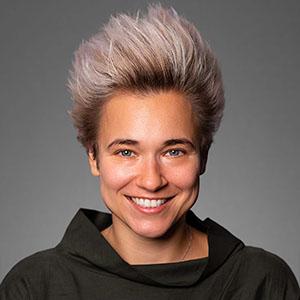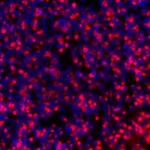
Yekaterina Andreevna Miroshnikova, Ph.D.
Stadtman Investigator
Section on Nuclear Mechanotransduction and Cell Fate Dynamics, Laboratory of Molecular Biology
NIDDK
Research Topics
Using cutting-edge, interdisciplinary approaches Miroshnikova lab aims to understand the role of nuclear mechanotransduction in modulating genome architecture and gene expression patterns to tune stem cell fate.
Current Research
Cells within active, self-renewing tissues such as the intestine and skin epidermis are constantly exposed to cell- and tissue-level forces that result in changes in nuclear shape and volume. Given the critical role of the three-dimensional organization of chromatin in transcriptional regulation, it is of importance to understand how nuclear shape and volume changes that occur during processes such as cell motility, polarization, and differentiation trigger specific changes in gene expression. Furthermore, nuclear shape and size abnormalities, in combination with chromatin distribution, are routinely utilized by clinicians to diagnose various cancers, highlighting the importance of detecting irregularities in nuclear shape. Yet, what precisely determines nuclear shape in health and disease, and how this is linked to cell fate and function remains a fundamental open question. Our laboratory addresses these key questions within two main research areas.
Extrinsic mechanical forces and nuclear deformation as active players in stem cell fate specification
It is known that mechanical forces that deform cells and their nuclei can alter chromatin state and transcription (Le et al. Nat. Cell Biol. 2016, Miroshnikova J. Cell Sci. 2017, Tajik et al. Nat. Mater., Nava, Miroshnikova Cell 2020), but the mechanisms remain unclear. Specifically, it is not clear if force-activated gene regulation involves direct, specific movements and remodeling of chromatin. Further is it not clear if force application can lead to permanent, fate-altering cellular events. To answer these questions we utilize induced pluripotent stem cells (iPS) in combination with 2- and 3-dimensional niche engineering, spectrum of mechanical manipulations coupled to high resolution genomics analyses and imaging to decipher both the short term transcriptional and chromatin accessibility effects, as well as long-term consequences on iPS differentiation trajectories.
Nuclear morphology and mechanics as functional and prognostic entities in intestinal homeostasis and colorectal cancer progression
A key open question in the field of epithelial cancers is at what precise stage of cancer do nuclear abnormalities arise and how do they affect cancer progression and aggression. Two hypotheses have emerged with respect to the relationship between nuclear shape, mechanics, and function. The first postulates that changes in nuclear shape and architecture alter bulk nuclear stiffness in order to allow cells to squeeze through tight spaces during invasion (soft nucleus) or withstand high mechanical loading (stiff nucleus) (Dahl et al. Circ. Res. 2008). The second hypothesis proposes that nuclear architecture abnormalities drive further genome instability and thus promote cancer progression (Webster et al J. Cell Sci 2009). These two hypotheses are not mutually exclusive. We investigate both the biophysical and genomic mechanisms and functional consequences of altered nuclear shape during cancer progression using clinical patient samples and patient-derived organoids.
Biography
- EMBO/HFSP Postdoctoral Fellow, Max Planck Institute for Biology of Ageing, Cologne Germany and Helsinki Institute of Life Sciences, Helsinki, Finland 2016-2020
- Whitaker Postdoctoral Fellow, Institute for Advanced Biosciences, 2015-2017
- Ph.D., Bioengineering, University of California San Francisco and Berkeley, 2015
- B.S., Engineering, Franklin W. Olin College of Engineering, 2009
Selected Publications
- Miroshnikova YA, Shahbazi MN, Negrete J, Chalut KJ, Smith A. Cell state transitions: catch them if you can. Development. 2023;150(6).
Related Scientific Focus Areas

Biomedical Engineering and Biophysics
View additional Principal Investigators in Biomedical Engineering and Biophysics




This page was last updated on Monday, April 21, 2025